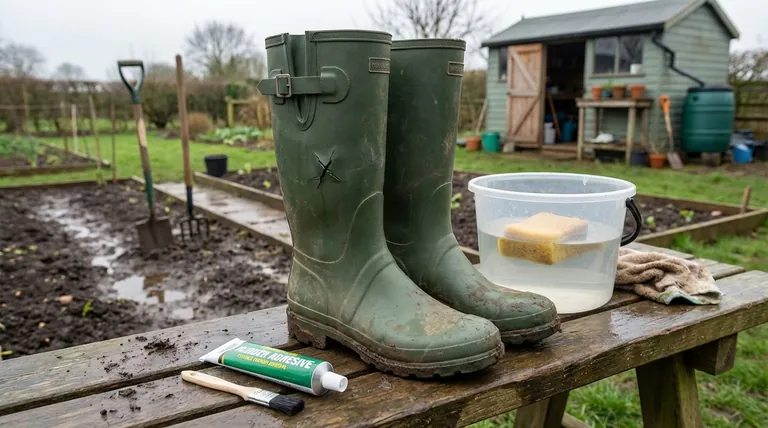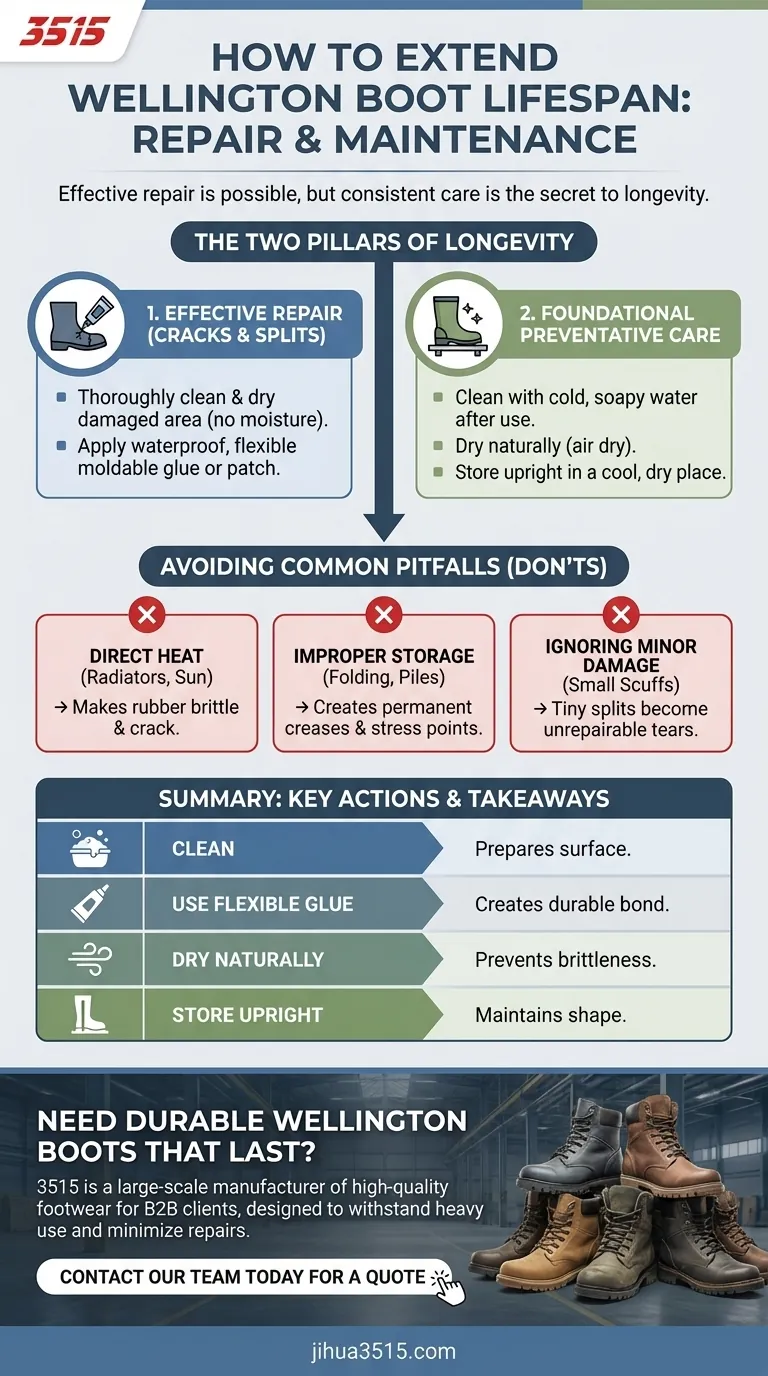Yes, wellington boots can be effectively repaired. For most common splits and cracks, the key is to use a waterproof and flexible adhesive, such as a moldable glue or a specialized rubber repair kit, after thoroughly cleaning and drying the damaged area.
While a strong repair can fix immediate damage, the true secret to extending a wellington boot's life lies in a consistent maintenance routine that prevents the rubber from becoming brittle and cracking in the first place.

The Two Pillars of Boot Longevity
Extending the life of your wellies isn't about a single action but a two-part strategy: responding to damage correctly and proactively preventing it. Most boot failures happen when the rubber degrades, but simple care can dramatically slow this process.
Step 1: Effective Repair for Cracks and Splits
When a boot splits, a successful repair depends on creating a strong, flexible, and waterproof bond.
First, thoroughly clean the damaged area with soap and water to remove all mud and debris. Allow it to dry completely, as any moisture will compromise the adhesive.
Next, apply a waterproof, moldable glue or a patch from a rubber repair kit. These materials are designed to flex with the boot as you walk, preventing the repair from cracking or peeling away.
Step 2: Foundational Preventative Care
The most effective repair is the one you never have to make. Basic care is your first line of defense.
After use, especially in muddy conditions, clean your boots with cold, soapy water. This removes dirt and chemicals that can degrade the rubber over time.
Always dry your boots naturally and thoroughly. Storing them while damp can encourage material breakdown.
Finally, store them in a cool, dry place away from direct sunlight or artificial heat sources.
Understanding the Trade-offs and Common Pitfalls
Many well-intentioned owners shorten their boots' lifespan by making a few common mistakes. Understanding these pitfalls is critical for long-term durability.
The Damage of Direct Heat
Never dry your wellies next to a radiator, fireplace, or in direct, intense sunlight. High heat causes the rubber to lose its natural plasticity, making it brittle and highly susceptible to cracking.
The Problem with Improper Storage
Storing boots by folding them over or tossing them in a pile creates permanent creases. These creases become stress points and are often the first places where splits appear. Use a boot stand or stuff the shafts to maintain their shape.
Ignoring Minor Damage
A tiny scuff or a small split is easy to fix. When ignored, daily flexing and stress will inevitably turn that small issue into a large, often unrepairable tear. Regular inspection allows you to address problems when they are still minor.
How to Apply This to Your Boots
Your approach should depend on the current state and intended use of your footwear.
- If your primary focus is fixing an existing tear: Your priority is to clean the damaged area meticulously before applying a flexible, waterproof adhesive for a lasting bond.
- If your primary focus is maximizing the lifespan of new boots: Establish a routine of cleaning after use, drying naturally, and storing them upright in a cool, dark place.
- If your primary focus is conditioning for heavy use: Regularly treat the rubber with a silicone spray or boot buffer to keep it supple and resistant to cracking.
By combining timely repairs with consistent, preventative care, you transform your wellington boots from a disposable item into a durable, long-term tool.
Summary Table:
| Action | Purpose | Key Takeaway |
|---|---|---|
| Clean with soapy water | Remove degrading dirt and debris | Prepares the surface for a strong repair. |
| Use flexible, waterproof glue | Creates a durable, moving bond | Prevents the repair from cracking again. |
| Dry naturally away from heat | Prevents rubber from becoming brittle | Direct heat is a primary cause of boot failure. |
| Store upright in a cool, dry place | Avoids permanent creases and stress points | Maintains boot shape and structural integrity. |
Need Durable Wellington Boots That Last?
As a large-scale manufacturer, 3515 produces a comprehensive range of high-quality footwear for distributors, brand owners, and bulk clients. Our production capabilities encompass all types of durable boots designed to withstand heavy use, minimizing the need for frequent repairs.
Let us provide you with reliable, long-lasting wellington boots that meet your specific needs. Contact our team today to discuss your requirements and get a quote!
Visual Guide

Related Products
- Durable Military Combat Boots with Water Drainage for Wholesale & OEM
- Durable Rubber Sole Outdoor Shoes Wholesale & Custom Manufacturing
- Wholesale Durable Mid-Cut Tactical Boots for Custom & Private Label Brands
- Durable Mid-Cut Tactical Boots for Wholesale & Private Label
- Wholesale Classic Leather Lace-Up Ankle Boots for Brand Manufacturing
People Also Ask
- What has been the global recognition of fabric for over 30 years? Industry's Trusted Benchmark for Durability
- How can a shiny finish be achieved on military boots? A Step-by-Step Guide to a Mirror Shine
- What are the key features of the new Army Jungle Combat Boot? A Breakdown for Hot & Wet Environments
- How do tactical boots and combat boots compare in breathability? Tactical Boots Offer Superior Airflow
- Why has Cordura remained relevant despite new fabrics? The Unbeatable Balance of Durability & Comfort













